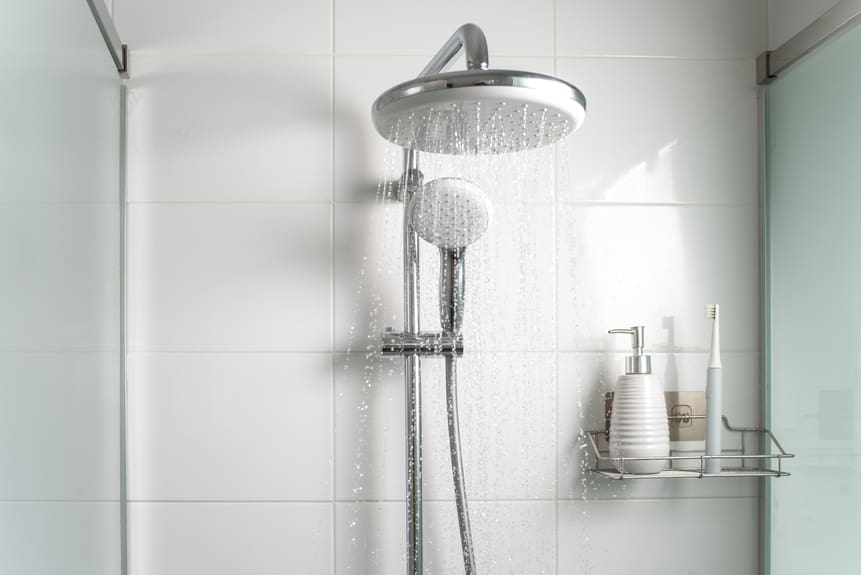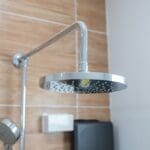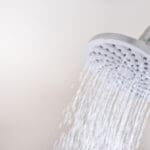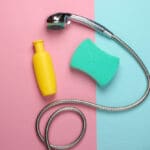It’s as if your shower head has developed a mind of its own, rebelliously dropping down and disrupting what should be the most serene part of your day. You’re not alone in this struggle, and the good news is that there’s a practical, straightforward path to reclaiming your shower’s reliability.
By following five essential steps—identifying the problem area, tightening connection points, applying plumber’s tape, replacing worn parts, and testing and adjusting—you’ll not only stop the incessant drooping but also enhance your shower’s overall performance.
Identify the Problem Area
First, you’ll need to pinpoint exactly where your shower head is failing to stay in place. This step is crucial in determining whether it’s an issue with the device holding the shower head or a problem within the showerhead itself. Often, a loose connection or wear and tear on parts can cause the shower head to droop or even detach completely.
If you observe water leaking from where the shower head connects to the arm, this is a clear sign that the connection is compromised. To fix a leaking shower head, you might need to remove the showerhead entirely to inspect the condition of the rubber washer inside. This washer is vital for ensuring a tight seal and preventing water from escaping the intended flow path. Over time, the washer can degrade or become misshapen, leading to leaks and affecting the stability of the shower head.
Once you’ve identified the problem area, you can take the appropriate steps to secure the shower head. Whether it’s tightening the connection, replacing the rubber washer, or adjusting the device holding the shower head, addressing the issue directly will restore proper function and water flow, ensuring your shower operates efficiently and securely.
Tighten Connection Points
After identifying the problem area, it’s crucial to tighten all connection points to prevent your shower head from dropping further. Ensuring your shower head stays in place involves more than just a quick fix. Follow these steps for a secure fitting:
- Use adjustable pliers or a wrench: Securely tighten any loose nuts or bolts. If it’s a handheld shower, ensure the hose connections are also tight.
- Check and replace washers: Look for any missing or damaged washers and install a new one where necessary. This helps in creating a watertight seal and stabilizes the showerhead back to its position.
- Apply Teflon tape: Before you tighten it by hand or with tools, wrap Teflon tape around the threaded connections. This ensures a water-tight seal and prevents future leaks that could cause the shower head to loosen.
- Double-check all connections: After tightening, go over each connection point again to ensure they’re as tight as possible without causing damage.
- Turn the water supply back on: Once everything is tight and secure, slowly turn the water on at the main shut-off to check for any leaks.
Apply Plumber’s Tape
To ensure a leak-proof seal, carefully wrap plumber’s tape clockwise around the shower arm’s threads before attaching the showerhead. This simple step is crucial in Home Improvement projects involving shower heads to prevent water from leaking inside the wall or affecting the water flow.
You’ll need to use just the right amount of plumber’s tape; too little, and you mightn’t create a tight enough seal to stop a leaking showerhead, too much, and you risk making the connection too bulky, which could hinder the smooth flow of water.
When wrapping, ensure the plumber’s tape covers the entire thread area. This coverage is essential to create an effective barrier that prevents water from escaping through the threads.
After applying the plumber’s tape, it’s time to reattach the showerhead. Gently screw it onto the shower arm by hand to avoid cross-threading or damage. Tighten sufficiently but avoid over-tightening, which could compromise the seal or damage the showerhead.
Replace Worn Parts
While applying plumber’s tape is a crucial step, it’s equally important to inspect and replace any worn parts on your shower head to maintain optimal performance.
Over time, parts inside of the shower can wear out, impacting the water pressure and causing the shower head to droop or leak. Here’s how you can tackle this issue:
- Remove the shower head by turning it counter-clockwise. You might need a flat-head screwdriver to gently pry it off if it’s tightly fixed.
- Inspect the washer inside the shower head. This small part controls the flow of water and can often be the culprit behind poor performance.
- Replace the old cartridge with a new one if you notice it’s worn or damaged. The cartridge is essential for the shower’s functioning, as it regulates water flow and temperature.
- Ensure everything is put back into place correctly. Align all parts snugly to prevent any leaks.
- Assemble the shower head back together, making sure all components fit securely.
Replacing these critical parts not only prevents your shower head from dropping but also ensures a consistent and enjoyable shower experience. Remember, regular maintenance is key to long-lasting shower hardware.
Test and Adjust
Having replaced any worn parts in your shower head, it’s crucial to test its functionality and make the necessary adjustments to ensure it remains firmly in place. Begin by turning on the water to check for any leaking or dripping. This step is vital to verify that the new cartridge inside the head is functioning correctly, ensuring no water escapes where it shouldn’t.
Next, adjust the angle and position of the head. You’re aiming for a balance where the showerhead continues to provide an optimal flow of both hot and cold water without slipping. If you notice the head is still dropping, it’s time to tighten any loose screws or connections. These are often the culprits behind a wobbly showerhead.
In some cases, you’ll need to go back a step and apply thread-sealing tape to the threads of the shower arm. This creates a tighter seal and prevents water from seeping through, which can cause the head to slip. Wrap the tape around the threads 2-3 times for the best effect.
Frequently Asked Questions
How Do I Stop My Shower Head From Dropping?
To fix your drooping shower head, first, tighten the bracket or replace the cartridge for a snug fit. Then, secure the handle and test for leaks by turning on the water supply.
How Do I Get My Shower Head to Stay Up?
To get your shower head to stay up, check its mounting bracket and tighten any loose connections. You might also need to replace worn-out parts or adjust the angle for a secure fit.
How Do You Stabilize a Shower Head?
To stabilize your shower head, first ensure it’s correctly attached to its arm. Tighten any loose connections and check the bracket for stability. If necessary, replace worn parts to secure the shower head firmly.





